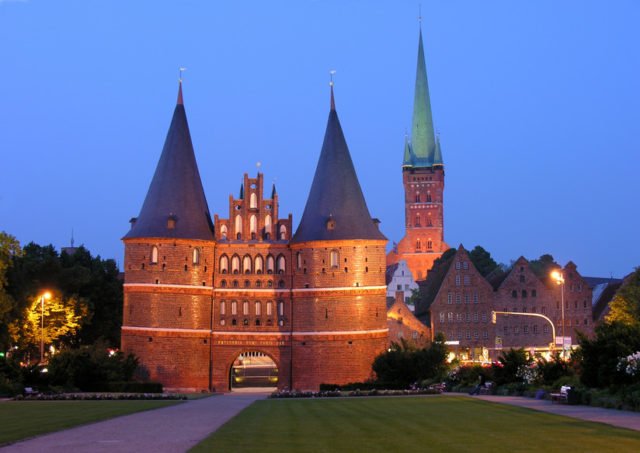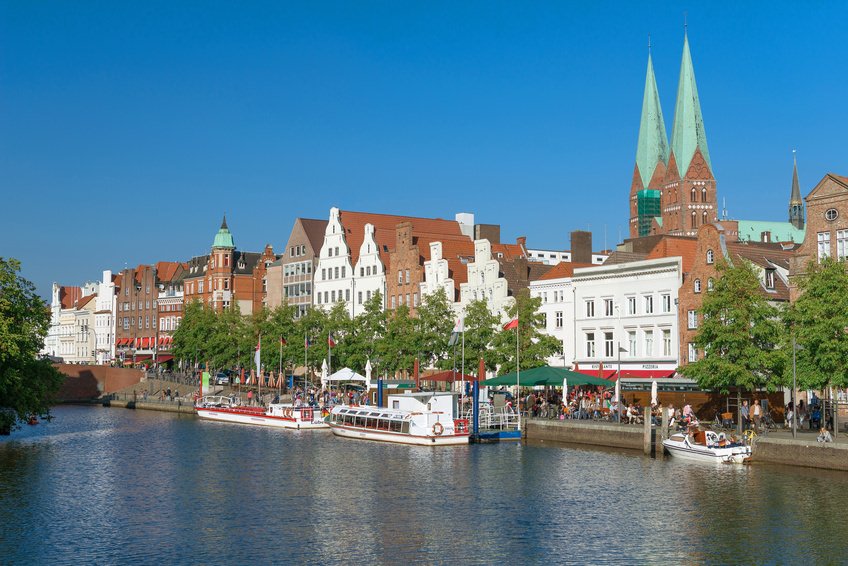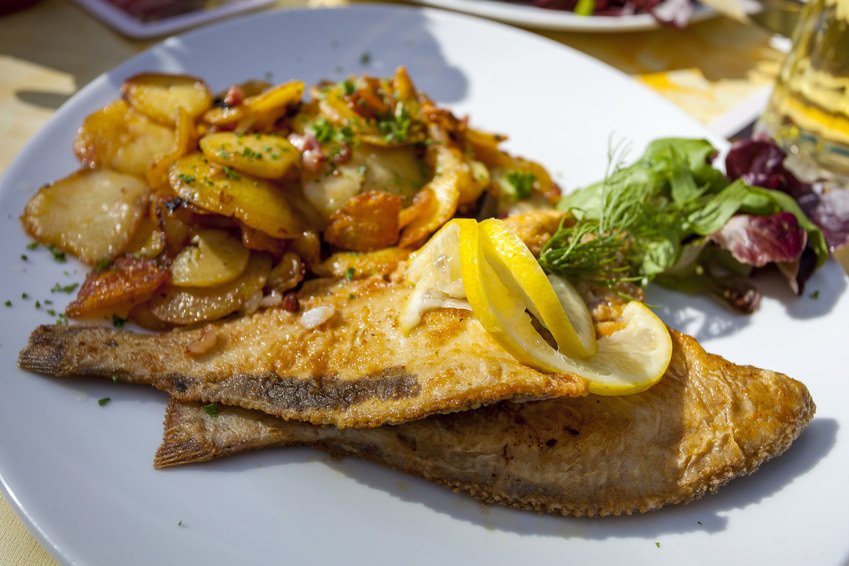
Once one of Europe’s wealthiest cities, Lübeck today is a fascinating mixture of old and new, with its population of around 230,000 giving it enough size to host world-class events but lending it an attractively intimate feel. An increasingly popular alternative to nearby Hamburg, and is a UNESCO World Heritage Site for its extraordinary collection of Hanseatic medieval architecture.
The old town, by far the most popular part with visitors, nestles on an island in the River Trave. Its stunning buildings remind you why Lübeck is dubbed “the Queen of the Hanseatic” – but this is no museum piece. Many people live and work in these historic buildings every day, giving Lübeck a real vibrancy and colour that tourists find enchanting.

City sights
Lübeck’s extraordinary Brick Gothic architecture is undoubtedly its most famous attraction. There are more than 1,000 historic buildings in the city, some of them original and some with World War Two bomb damage having been lovingly restored. The Holstentor, one of the two surviving medieval gates, has become a symbol of Lübeck and is a great place to start. The Schiffergesellschaft is also a must-see, a pyramid-shaped building that was once a meeting place for seafarers but now serves outstanding local seafood.
Three Lübeckers were awarded Nobel Prizes, and the city boasts several fine museums set up in their honour: authors Gunter Grass and Thomas Mann have one each, as does statesman Willy Brandt. Culture vultures might prefer to head for the St Annen Museum, which specialises in medieval sculpture. If you’re bringing the kids, an obvious choice is the Niederegger Marzipan Museum, where you can admire startling sculptures and then enjoy a marzipan-tastic meal in the excellent café.
Given Lübeck’s island location, a boat tour is a great way to spend an hour or two. You’ll get a very different perspective on the city’s sights from the water, and everything seems slower and more relaxed while you’re aboard. A few trips run all year, but most are available between Easter and October. Expect to pay around 15 € for a tour of the harbour and canal areas.

Arriving
- By air: the nearest international airport is Hamburg, around 40 miles away. Trains run regularly (every 30-60 minutes) from Hamburg’s central station to Lübeck, though they are not particularly fast.
- By road: The two major highways to Lübeck are the modern A20 autobahn from Rostock along the Baltic Sea coast, and the older A1 autobahn from Hamburg.
- By rail: Some long-distance trains from Berlin, Cologne, Frankfurt and Munich call at Lübeck, and there is an international rail service from Copenhagen.
- By sea: Several ferries call at Lübeck’s seaport of Travemünde. TT-Line operates services from Trelleborg, while Finnlines ships run from Helsinki and Malmö.
Getting around
There isn’t much reason to drive in Lübeck, as most of the sights of interest are concentrated in the relatively compact centre. There is a reasonable local bus service, but most visitors either take taxis or walk. Lübeck’s taxis are safe and reliable, but not always very cheap! Even so, they make a good option if you’re heading out late at night. In the daytime, walking is the best way to see the city, as it’s fairly flat and – because of being on an island – hard to wander too far from your intended route. Even if you do get lost, treat it as part of your adventure: you may discover a wonderful hidden gem!
When to go
Lübeck’s position close to the north coast of Germany gives it a maritime climate. There are few scorchingly hot days in summer, while even in midwinter the city is milder than those further inland. Rainfall is fairly evenly spread, but the sunniest days are usually between late April and early September, with May the sunniest month of all at 223 hours. Relatively few tourists visit in the winter months, when there is little crowding but many tourist attractions are closed. The exception is in the run-up to Christmas, when the huge market is a major attraction.
Nightlife
Lübeck may not be one of Europe’s traditional party capitals, but that doesn’t mean you can’t have fun after the sun goes down! Clubs usually close around 2-3 am, with few of the legendary all-night events you’d find in Berlin or even Hamburg. For something a little different, head to the Wallhalbinsel Peninsula, where you’ll find the Strandsalon. Although there’s plenty of live music on offer, the club also offers an interesting programme of films. Many people like to relax with one of the club’s famous cocktails.
There are plenty of late-night bars to suit all tastes. Often, these are the same venues that act as coffee shops in the daytime, so don’t be fooled! Ask around locally to find out which DJs will be playing – Friday and Saturday nights in summer are the busiest, but many people also like to go out on Thursday evenings, when the atmosphere is a little more laid back.
Believe it or not, there’s even an Irish pub in Lübeck! You’ll find this little piece of the Emerald Isle in the old town’s Mengstraße. If you’re feeling adventurous and your German is really good, you could even enter for the open mic night held on each month’s opening Thursday! Guinness is always available, of course, but be aware that the pub is closed on Mondays.
Hotels
There’s no shortage of accommodation in Lübeck to suit all budgets, with the historic part of the city being the most popular. The Radisson Blu Senator in Willy-Brandt-Allee has a stellar reputation and a wonderful waterfront setting, though you’ll pay for the privilege: rooms average 200 € a night. A good mid-range option is the Ringhotel Jensen, a characterful historic building in the old town and costing around the 120 € mark. Those on a budget could look to the Ibis, which is a no-frills affair but is very conveniently situated opposite the main train station.
Local cuisine
Lübeck enjoys an excellent reputation for its regional specialties; along with the nearby cities of Hamburg and Bremen the area is renowned as the home of some of northern Germany’s finest cooking. Among the best dishes to try are:
- Marzipan – this is by far the marzipan capital of Germany, and maybe the world! If you have even a slight sweet tooth, it’s hard to resist the premium marzipan produced by local makers.
- Seafood – the fish caught and served here is truly mouthwatering, with the freshest cod, plaice and herring all featuring on local menus. Try tangy cod in mustard sauce or dishes made from miniature Baltic shrimps.
- Lübecker National is a very popular pork stew. Local vegetables such as onions, potatoes and carrots are added, and the result is a hearty, filling meal!
- Rote Grütze – if you find marzipan too much of a good thing, this dessert of red berries is the perfect option. It’s usually served with vanilla ice cream to offset the sharpness of the fruits.
- Lübecker Plettenpudding – otherwise known as “diplomat pudding”, this tasty layered dessert features sponge biscuits, egg custard and fruit (often raspberries), served cold and sometimes topped with sherry.
- Lübecker Rotspon – Lübeck’s most famous wine actually starts life in France, but is then imported to spend time maturing in local oak barrels. You’ll often find it offered with sherry as an aperitif.
© S.H.exclusiv / Fotolia Rote Grutze © Martin Rettenberger / Fotolia Plaice with fried potatoes © A_Bruno / Fotolia
Shopping
Although Lübeck is a relatively small city, it still offers something for retail enthusiasts. The main shopping streets are the Fleischhauerstraße and the Hüxstraße, both of which are situated on the edge of the old town in the city centre. The bookshop at the Rathaus a little way to the west is a nice place to pick up books and souvenirs of Lübeck, but for a quirkier present look for street artists producing their own versions of the city’s landmarks – unsurprisingly, the Holstentor is a very popular subject! Another popular gift is local food and drink, especially local marzipan or Rotspon wine; these can be found everywhere!
Nearby
Although Lübeck offers a lot by itself, you may feel like the occasional trip out, so here are a few suggestions. Outdoor sports enthusiasts should head for the Schwentine Valley north of the city towards Kiel. This offers plenty of hill-walking in interesting countryside as well as canoe hire during the summer months. Alternatively, the Ratzeburger See lake to the south is a birdwatcher’s paradise. It’s also worth taking the train to Hamburg to visit the artworks on display in the three Kunsthalle galleries. And don´t forget to check out Travemunde, which is also part of Lubeck and their seaside resort.












